
Windsor chair
Encyclopedia
A Windsor chair is a chair
built with a solid wooden seat into which the chair-back and legs are dowelled, or pushed into drilled holes, in contrast to standard chairs, where the back legs and the uprights of the back are continuous. The seats of Windsor chairs were often carved into a shallow dish or saddle shape for comfort. Traditionally, the legs and uprights were usually turned on a pole-lathe. The back and sometimes the arm pieces (if arms are present) are formed from steam bent pieces of wood
.
, where the main centre of production eventually moved to High-Wycombe. The first Windsors were of the comb-back variety. By the 18th century steam bending was being used to produce the characteristic "bow" of the Windsor chair. The first chairs made this way were shipped to London from the market town of Windsor
, Berkshire
in 1724. There is speculation that the chair derives it's name from the town of Windsor which became the centre for the trade between the producers and the London dealers. Thus the name "Windsor Chair" is more about the style of chair rather than where it was made with many diverse forms of Windsor chair being made worldwide.
It is common to find American Windsors made in the 18th century that contain three different species of wood. Pine
, bass or tulip poplar are common for the seat. Non ring porous hardwoods such as Maple
are stiff and make crisp turnings, and were used for the undercarriage. Ring porous species such as Oak
, ash
, and hickory all rive (split) and steam bend nicely. These woods are also straight grained and flexible and thus work well for slender parts such as the spindle
s.
The seat of a Windsor chair is an essential part since it provides the stability to both the upper and lower portions. The thickness of the seat allows the legs to be anchored securely into their respective tapered sockets, providing the undercarriage with strength and stability. A timber that will provide the strength and stability whilst also allowing it to be shaped, in order to achieve the desired look and feel, requires a strong durable timber, with interlocking grain, to provide the right characteristics. English Windsors typically have elm
seats because its interlocking grain gives good cross-grain strength that resists splitting where holes are placed close to the edge of a seat. There are no real satisfactory alternatives to elm although other woods have been tried, for example, oak and ash in Britain and various types of pine in the USA. Because of elm's strength compared to pine, tulip poplar or bass, English Windsor chair seats are usually not as thick as American Windsors. The English Windsor chair seats are not saddled (or dished) as deeply as their American counterparts- partly because of elm's relative strength, and partly because elm is comparatively more difficult to sculpt than the softer woods chosen by American chair makers.
The legs are splayed at angles fore-and-aft (rake) as well as side-to-side (splay) to provide actual and visual support of the person sitting. Early chairs made in America usually have stretchers connecting the front and back legs and a cross stretcher connecting the two side stretchers, creating what is known as an "H" stretcher assembly. A common misconception about this assembly is that the stretchers hold the legs together in order to keep them from pulling apart. In the traditional Windsor design, the wedged tenon joint which joins each leg to the seat is strong enough in itself to prevent the legs from creeping outward. The stretcher system actually pushes the legs apart to retain the necessary tension which reduces slack.
"Through-holed and wedged" is one of the primary means of joining Windsor chair parts. A cylindrical or slightly tapered hole is bored in the first piece, the matching cylindrical or tapered end of the second piece is inserted in the hole as a round tenon, and a wedge is driven into the end of this tenon, flaring it tight in the hole. The excess portion of the wedge is then cut flush with the surface. This supplies a mechanical hold that will prevail when the glue fails. In general, early Windsor chair joints are held together mechanically, making glue a redundant detail in their assembly.
for protection of the fragile paint. In the 19th century settlers from the mid-west of America to Ontario
, Canada
would coat their chairs with the solid primary colours of milk paint
, a mix of buttermilk, turpentine and cow's blood.
During the early 19th century the United States produced vast amounts of chairs, in factories, and an experienced factory painter could paint a chair in less than five minutes. By mid-century, to save production costs, the chair was painted in solid colours with some simple stencilling being the only design.
With wear in use, the paint wears off around the edges and displays a characteristic wear pattern that reveals the paint colors underneath. As for any antique, this original finish often survives best in unworn areas such as the bottom of the seat or around turnings. Later repainting, even well-intentioned restoration, will diminish the value of an original finish.
Chair
A chair is a stable, raised surface used to sit on, commonly for use by one person. Chairs are most often supported by four legs and have a back; however, a chair can have three legs or could have a different shape depending on the criteria of the chair specifications. A chair without a back or...
built with a solid wooden seat into which the chair-back and legs are dowelled, or pushed into drilled holes, in contrast to standard chairs, where the back legs and the uprights of the back are continuous. The seats of Windsor chairs were often carved into a shallow dish or saddle shape for comfort. Traditionally, the legs and uprights were usually turned on a pole-lathe. The back and sometimes the arm pieces (if arms are present) are formed from steam bent pieces of wood
Wood
Wood is a hard, fibrous tissue found in many trees. It has been used for hundreds of thousands of years for both fuel and as a construction material. It is an organic material, a natural composite of cellulose fibers embedded in a matrix of lignin which resists compression...
.
History
It is not clear when then first Windsor Chairs were made. It is known that, as early as the 16th century, wheelrights started coping out chair spindles in the same way they made wheel spokes. The design was probably a development of West Country, Welsh and Irish 'stick-back' chairs, but the evidence on origin is not certain. It is thought that the first Windsor chair, made its appearance in the county of BuckinghamshireBuckinghamshire
Buckinghamshire is a ceremonial and non-metropolitan home county in South East England. The county town is Aylesbury, the largest town in the ceremonial county is Milton Keynes and largest town in the non-metropolitan county is High Wycombe....
, where the main centre of production eventually moved to High-Wycombe. The first Windsors were of the comb-back variety. By the 18th century steam bending was being used to produce the characteristic "bow" of the Windsor chair. The first chairs made this way were shipped to London from the market town of Windsor
Windsor, Berkshire
Windsor is an affluent suburban town and unparished area in the Royal Borough of Windsor and Maidenhead in Berkshire, England. It is widely known as the site of Windsor Castle, one of the official residences of the British Royal Family....
, Berkshire
Berkshire
Berkshire is a historic county in the South of England. It is also often referred to as the Royal County of Berkshire because of the presence of the royal residence of Windsor Castle in the county; this usage, which dates to the 19th century at least, was recognised by the Queen in 1957, and...
in 1724. There is speculation that the chair derives it's name from the town of Windsor which became the centre for the trade between the producers and the London dealers. Thus the name "Windsor Chair" is more about the style of chair rather than where it was made with many diverse forms of Windsor chair being made worldwide.
Forms and construction
There are about seven distinctive forms. These include:- Sack-back
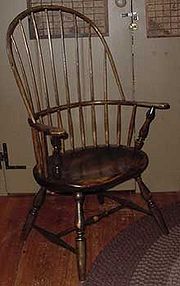
- Hoopback
- Comb-back
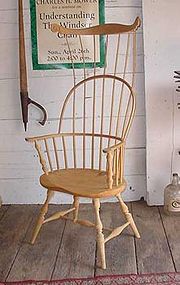

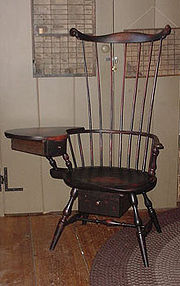
- Continuous arm
- Low back
- Rod back
- Fan back
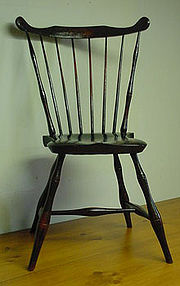
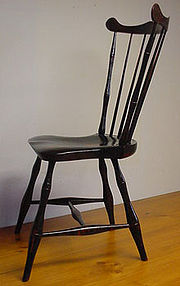
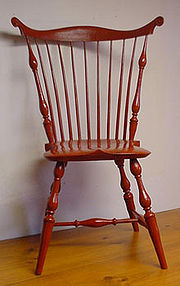
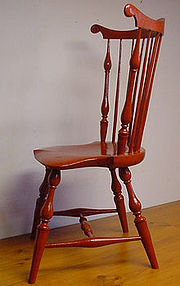
It is common to find American Windsors made in the 18th century that contain three different species of wood. Pine
Pine
Pines are trees in the genus Pinus ,in the family Pinaceae. They make up the monotypic subfamily Pinoideae. There are about 115 species of pine, although different authorities accept between 105 and 125 species.-Etymology:...
, bass or tulip poplar are common for the seat. Non ring porous hardwoods such as Maple
Maple
Acer is a genus of trees or shrubs commonly known as maple.Maples are variously classified in a family of their own, the Aceraceae, or together with the Hippocastanaceae included in the family Sapindaceae. Modern classifications, including the Angiosperm Phylogeny Group system, favour inclusion in...
are stiff and make crisp turnings, and were used for the undercarriage. Ring porous species such as Oak
Oak
An oak is a tree or shrub in the genus Quercus , of which about 600 species exist. "Oak" may also appear in the names of species in related genera, notably Lithocarpus...
, ash
Ash tree
Fraxinus is a genus flowering plants in the olive and lilac family, Oleaceae. It contains 45-65 species of usually medium to large trees, mostly deciduous though a few subtropical species are evergreen. The tree's common English name, ash, goes back to the Old English æsc, while the generic name...
, and hickory all rive (split) and steam bend nicely. These woods are also straight grained and flexible and thus work well for slender parts such as the spindle
Spindle (furniture)
A Spindle, in furniture, is an cylindrically symmetric shaft, usually made of wood. A spindle is usually made of a single piece of wood and typically has decoration fashioned by hand or with a lathe...
s.
The seat of a Windsor chair is an essential part since it provides the stability to both the upper and lower portions. The thickness of the seat allows the legs to be anchored securely into their respective tapered sockets, providing the undercarriage with strength and stability. A timber that will provide the strength and stability whilst also allowing it to be shaped, in order to achieve the desired look and feel, requires a strong durable timber, with interlocking grain, to provide the right characteristics. English Windsors typically have elm
Elm
Elms are deciduous and semi-deciduous trees comprising the genus Ulmus in the plant family Ulmaceae. The dozens of species are found in temperate and tropical-montane regions of North America and Eurasia, ranging southward into Indonesia. Elms are components of many kinds of natural forests...
seats because its interlocking grain gives good cross-grain strength that resists splitting where holes are placed close to the edge of a seat. There are no real satisfactory alternatives to elm although other woods have been tried, for example, oak and ash in Britain and various types of pine in the USA. Because of elm's strength compared to pine, tulip poplar or bass, English Windsor chair seats are usually not as thick as American Windsors. The English Windsor chair seats are not saddled (or dished) as deeply as their American counterparts- partly because of elm's relative strength, and partly because elm is comparatively more difficult to sculpt than the softer woods chosen by American chair makers.
The legs are splayed at angles fore-and-aft (rake) as well as side-to-side (splay) to provide actual and visual support of the person sitting. Early chairs made in America usually have stretchers connecting the front and back legs and a cross stretcher connecting the two side stretchers, creating what is known as an "H" stretcher assembly. A common misconception about this assembly is that the stretchers hold the legs together in order to keep them from pulling apart. In the traditional Windsor design, the wedged tenon joint which joins each leg to the seat is strong enough in itself to prevent the legs from creeping outward. The stretcher system actually pushes the legs apart to retain the necessary tension which reduces slack.
"Through-holed and wedged" is one of the primary means of joining Windsor chair parts. A cylindrical or slightly tapered hole is bored in the first piece, the matching cylindrical or tapered end of the second piece is inserted in the hole as a round tenon, and a wedge is driven into the end of this tenon, flaring it tight in the hole. The excess portion of the wedge is then cut flush with the surface. This supplies a mechanical hold that will prevail when the glue fails. In general, early Windsor chair joints are held together mechanically, making glue a redundant detail in their assembly.
| Assembling wedged tenon joints | ||
 |
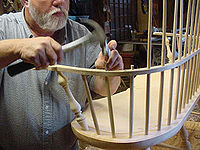 |
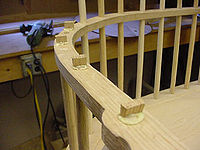 |
Painted finishes
Early British Windsors were painted, later versions were stained and polished. American Windsors were usually painted, in the 18th century they were grain painted with a light color, then overpainted with a dark color before being coated with linseed oilLinseed oil
Linseed oil, also known as flaxseed oil, is a clear to yellowish oil obtained from the dried ripe seeds of the flax plant . The oil is obtained by cold pressing, sometimes followed by solvent extraction...
for protection of the fragile paint. In the 19th century settlers from the mid-west of America to Ontario
Ontario
Ontario is a province of Canada, located in east-central Canada. It is Canada's most populous province and second largest in total area. It is home to the nation's most populous city, Toronto, and the nation's capital, Ottawa....
, Canada
Canada
Canada is a North American country consisting of ten provinces and three territories. Located in the northern part of the continent, it extends from the Atlantic Ocean in the east to the Pacific Ocean in the west, and northward into the Arctic Ocean...
would coat their chairs with the solid primary colours of milk paint
Milk paint
Milk paint is a non-toxic water based mixture used as a paint. It is made from milk and lime with or without pigments added for color. Borax may be added to the milk paint recipe to assist the lime in dissolving the casein and as a preservative....
, a mix of buttermilk, turpentine and cow's blood.
During the early 19th century the United States produced vast amounts of chairs, in factories, and an experienced factory painter could paint a chair in less than five minutes. By mid-century, to save production costs, the chair was painted in solid colours with some simple stencilling being the only design.
With wear in use, the paint wears off around the edges and displays a characteristic wear pattern that reveals the paint colors underneath. As for any antique, this original finish often survives best in unworn areas such as the bottom of the seat or around turnings. Later repainting, even well-intentioned restoration, will diminish the value of an original finish.

